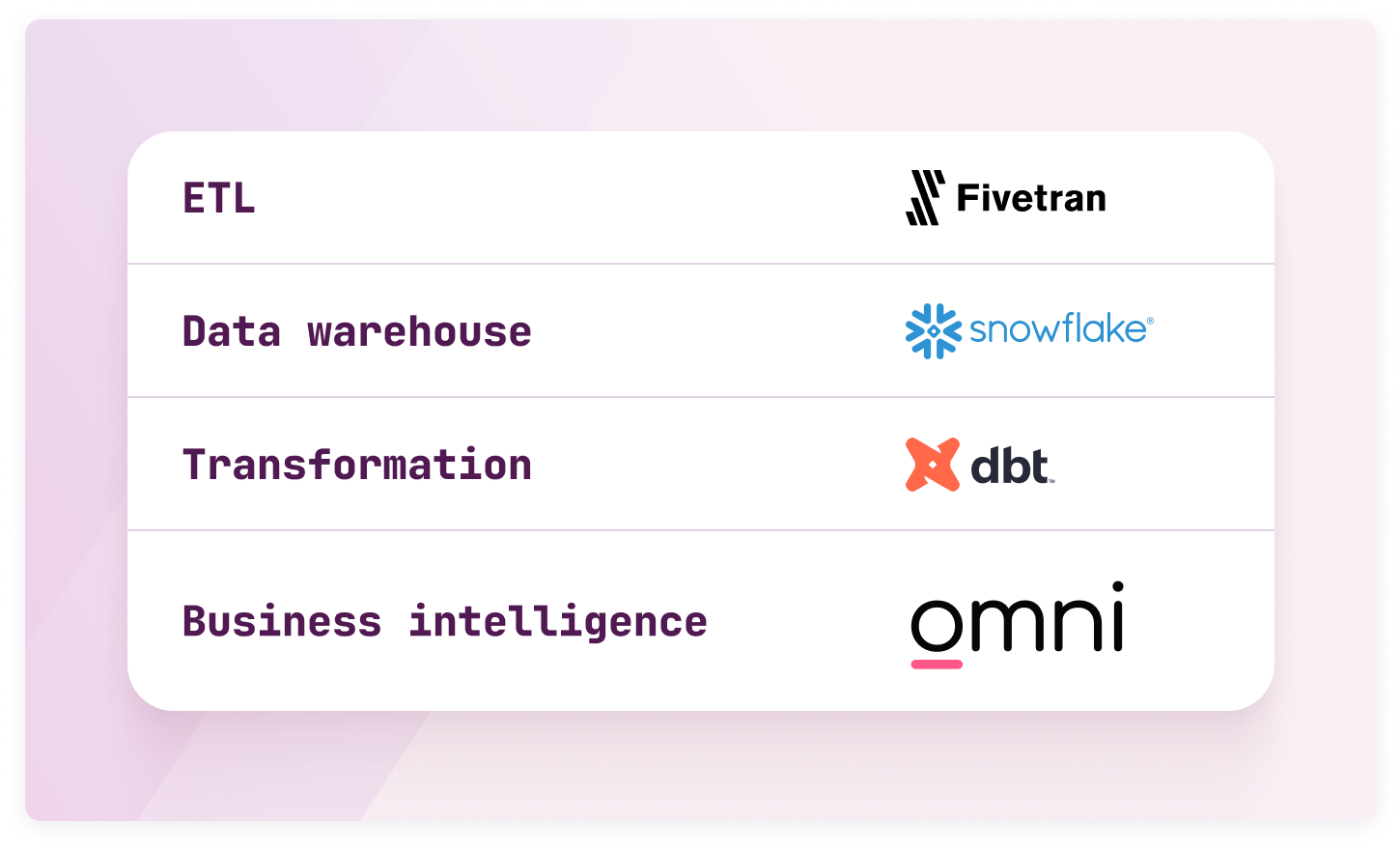
Trint’s AI turns audio and video recordings into text in more than 50 languages. Beloved by journalists, content creators, law firms, and startups, Trint makes it easy to turn interviews and conversations into articles, case studies, rough cuts, and captioned videos — even on tight timelines. Unlike many automated transcription tools, Trint never uses customer data to train its models, keeping sensitive information safe for industries where privacy is a primary concern.
Naturally, Trint has significant in-house expertise in data and machine learning on their Product and Engineering teams. As a startup, they need to support operational data use cases with limited resources. “We have data analysts embedded within most of our functional teams, and a few of us are working on our data infrastructure,” explains Anya Osen Barnett, Trint’s Senior Analytics Engineer.
With Trint’s previous BI solution, building and maintaining data models and dashboards took considerable time. Most modeling and administrative work fell to Anya, and given the rapid pace of product development and other initiatives at the company, it was difficult to keep up with every team’s needs.
By moving to Omni’s BI platform, Trint was able to:
- Set up internal business users for success within the first month: With help from Omni and Hawkfry Group, Trint was able to migrate their data models and operational content as well as onboard business users — all within the first 30 days.
- Increase speed of data access: The Revenue Operations and Product teams can now extract and join data independently without being bottlenecked by Data Engineering.
- Get more value out of their budget: Trint not only spends less on BI than it previously did but also receives considerably more hands-on support that conserves the team’s time and resources.
Key elements of Trint’s data stack

When discussing Trint’s data stack, Anya highlighted Snowflake as a favorite. “It’s a bit niche but I really love Snowflake’s SQL syntax. It’s just more advanced than other dialects of SQL,” explains Anya. “When you’re trying to duplicate something, you would normally have to create another CTE, and that ends up being very bulky. With Snowflake, you can just use the QUALIFY clause instead.”
Evaluation: The search for a powerful, flexible BI solution
The Trint team adopted its previous BI tool because they needed backend modeling capabilities. The tool, while powerful, had limitations. “Our previous tool was very prescriptive,” says Anya. “For example, if you just needed to write a single SQL query that you didn’t want repeated, it would be difficult — you’d have to start creating derived views.”
The previous tool’s lack of flexibility also restricted the number of internal users who could self-serve without needing help from Anya and Data Engineering, so the team went looking for an alternative.
"We tried to make self-service possible, but it didn't really work with our previous BI tool. In order to make any changes to our data model, you'd have to be quite well-versed in SQL. That's fine for a data analyst, but not for other team members." Anya Osen Barnett, Senior Analytics Engineer
In their initial search, the team considered several BI solutions, but they didn’t meet all of Trint’s requirements. “They were either too slow, or lacked the data modeling capabilities that we needed,” says Anya.
Anya eventually looked into Omni based on a colleague’s recommendation. “We got access to a trial where we could thoroughly test the product before signing any contracts, and that made a big difference. It gave me a chance to assess the similarities and differences between our existing tool and Omni. I discovered that Omni had a lot of the same capabilities, but was also easier for less technical people to use.”
"A big problem we had with our previous tool was people creating metrics that had the same name but different definitions. With Omni, we can label content as "verified," so when someone is looking for a metric, it's easy to find the correct number. Now, everyone is singing off the same song sheet." Anya Osen Barnett, Senior Analytics Engineer
Migration: Establishing a true partnership in less than a month
One of the key deciding factors for Trint was the hands-on support from Omni’s team and its partner network. “We worked with Jamie Fry from Hawkfry Group on the migration. Jamie helped me move over our model and dashboards in less than a month and trained a lot of our team. The trainings were specific to the type of data that each team would be working with, so each function ended up getting practical advice and valuable insights instead of just a general how-to.”
"Having support through the migration from Omni and Hawkfry Group was a real lifesaver for us." Anya Osen Barnett, Senior Analytics Engineer
Because Trint had 30 days to migrate their content, the team took it as an opportunity to do a bit of spring cleaning — getting rid of models and dashboards that were redundant or no longer needed. “We only used about 25% of our dashboards regularly. Same with views,” says Anya.
Once the initial data model was set up and the high-priority content had been migrated, the Data Engineering team opened up Omni to new users across the business “We ended up having team members who weren’t previously comfortable using our BI tool ask for access to Omni, and now we have more people actively using BI with Omni than before.”
Use Cases: How Omni unblocks Product, Operations, and Data Engineering
Anya started noticing changes to the way the team worked soon after implementing Omni. The Product and Operations teams were able to take over tasks they once had to submit requests for. As a result, the data model today more accurately reflects the current state of the product, and internal users are able to get insights faster.
Anya explains how Omni has changed the workflow for key teams within the business: Finance, Revenue Operations, Product Development, and her own team, Data Engineering.
Revenue Operations
Trint offers several plans with different pricing: monthly, quarterly, and annually. While customers love the flexibility, it makes working with the data more difficult.
“Previously, the Revenue Operations team had to teach themselves quite a bit just to get the insights they needed — and even then it wasn’t always feasible. Omni has been transformative for them. Before they needed to use SQL or custom coding language to create joins, but now they can do it through Omni’s UI, and that has massively sped up their process.”
Omni’s Calculations feature is of particular benefit to this function. “Omni opens up data exploration to more people on the team. Our previous tool required expertise in SQL or custom coding language to do calculations, but Omni Calculations use Excel syntax which makes things much easier for people. Most people already understand Excel and are comfortable using it. Even if you don’t know a formula, you can just type what you want to calculate and the AI will do it for you. It’s a lot faster than what we were doing before.”
Product Development
The Product team previously had to submit a ticket every time they needed to add or adjust events or their properties. “The team at Trint uses Mixpanel for product data and that comes through a JSON file,” explains Anya. “Historically, whenever there was a new property or a change to one, we’d have to first model it within dbt and then create a new column. That wasn’t something that product managers could do on their own.”
Today, the team can read new JSON directly in Omni and model as they analyze. “It’s great for the Product team because they don’t have to wait on me to fulfill the tickets, and it’s a huge time saver for me personally. To be honest, we didn’t even know this feature existed when we were vetting Omni but it’s a huge plus for us.”
"I used to get more requests every month asking to add or remove events and properties. Now, it's easier for the Product team to make those updates on their own — they don't have to wait and it allows me to focus on other projects." Anya Osen Barnett, Senior Analytics Engineer
Data Engineering
In addition to making functions more self-sufficient and reducing the volume of requests, Omni has also made Anya’s work simpler — eliminating the repetitive work to maintain tools in the data stack and speeding up modeling with Excel formulas and Calculations AI.
"Every time I make a change to the model in dbt, all I need to do is refresh the schema, and the change is reflected in Omni automatically. Before, it was manual. We had a whole section of tickets just reminding us to make the corresponding changes in our previous BI tool." Anya Osen Barnett, Senior Analytics Engineer
Omni’s integration with dbt reduces redundant work when it comes to updating the data model and syncing dbt documentation. “I’m a huge proponent of good documentation, but it’s always hard to keep up-to-date. I know that only having to add in one place will be game-changing.”
Many of the improvements Anya shared are powered by capabilities and features that the Trint team wasn’t explicitly looking for in a BI solution. As the team continues working with Omni, and Omni continues to develop, Anya expects to see even more positive changes in the way the team works with — and benefits from — data.